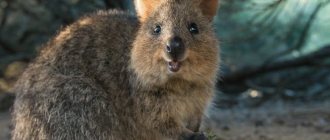The narwhal is a small toothed whale that lives in Arctic coastal waters and rivers. Its distinctive feature is a long tusk protruding forward above the mouth. Because of him, the narwhal received the nickname “unicorn of the sea.”
Narwhals and beluga whales are close relatives, together making up the family Monodontidae (narwhals) of the suborder Odontoceti (toothed whales). The name "narwhal" comes from the Old Norse words "nar" (corpse) and "hvalr" (whale). “Corpse” refers to the mottled gray coloration of the narwhal, reminiscent of the skin color of drowned sailors. The animal's scientific name, Monodon monoceros, comes from the Greek words meaning “one-toothed” and “one-horned,” respectively.
Appearance
Perhaps the most noticeable feature of the narwhal is the presence of a “tusk” that can grow up to 3 meters in length. The tusk is actually a massive fang protruding from the narwhal's upper left lip. Tusks grow mainly in males. Narwhals have only two teeth; As a rule, the left tooth erupts, but the right tooth remains undeveloped. In most females both teeth remain vestigial, however in rare cases both sexes may develop both canines. If both canines are present, the left one is always larger. All tusks are twisted in a counterclockwise spiral and have a polished end.
Photo: www.arctickingdom.com
Although many theories have been put forward regarding the primary function of the narwhal's tusk, recent observations suggest that the males use their enormous tusk to hunt fish and sense the salt level of the water in which they swim. Previously, reputable scientists, including the English naturalist Charles Darwin, believed that males use their fangs when fighting for females.
Narwhals also have three more unique physical characteristics:
- absence of a dorsal fin. Instead of a dorsal fin, narwhals have a dorsal crest. The dorsal ridge and the notches on it are unique and can be used to identify individuals.
- articulated neck. Unlike most other whales and dolphins, the narwhal has an articulated neck, rather than a rigid or fused neck. This means that the animal can move its head separately from its body.
- changes in body color with age. Narwhals are white or light gray at birth. As these toothed whales mature, the colors begin to turn darker, creating a mottled pattern. The young are bluish-black in color. Adults have a dark, spotted back and a cream-colored ventral region. As they age, they become lighter again; very old individuals become almost completely white.
Interesting facts about the animal
Let's learn interesting facts about the sea unicorn:
- Since the 12th century, traders have sold the animal's tusks, passing them off as alicorns - the horns of the mythical unicorn. They were worth more than gold.
- The lifespan of a mammal in captivity is no more than 6 months.
- Thanks to thousands of nerve endings on the tusk, the animal is able to detect water pressure and temperature.
- A narwhal tusk is a modified tooth containing nerves. This part of the body is used as a receptor. Females have tusks that are not as large as those of the opposite sex.
- The narwhal uses its horn to force fish to the surface from the bottom.
- There are known cases of sea unicorns attacking whales. Most likely this was an accidental collision.
- The mammal does not have a fin on its back.
- A third of the animal’s total mass is fat, reaching a thickness of 10 cm.
- The narwhal will not be able to live in warm water.
- The largest tusk is 3 m long. It weighs about 10 kg.
- If the horn breaks, it will never grow back and will be sealed with a bone filling.
- According to an old belief, a piece of narwhal tusk in a glass of poisoned drink can change its color.
- Individuals are very talkative among themselves.
Freedom-loving narwhals do not tolerate captivity, so it is better to protect these amazing animals from a distance.
Do you have any questions about Narwhals or something to add? Then write to us about it in the comments, this will make the material more useful, complete and accurate.
Size
Adult narwhals range from 4 to 5 meters in length and weigh from 900 to 1,600 kg, with males being larger than females. Newborn cubs reach 1.5 meters in length and usually weigh about 80 kg. A typical narwhal has 30-35% of its weight in fat. This layer of fat, 50 to 100 mm thick, is essential for survival in cold Arctic waters. Narwhals can also be identified by their fins, which are smaller than those of most other cetaceans and have a distinctive upward-curved tip.
Photo: Wildestanimal/Getty Images
Geographic range
Narwhals are found in the Arctic and Atlantic oceans. They are considered the most northern cetaceans. Narwhals can usually be found in areas between 70° and 80° north latitude. Large populations occur in northeastern Canada, Greenland and northern Russia to the East Siberian Sea. They are rarely seen on the surface, so it is likely that they are found in other places.
This is a migratory species of toothed whale. During the summer, narwhals are found in the northern Canadian Arctic, off the east coast of Greenland. In late September, most individuals begin migrating south to their winter homes in Baffin Bay. The onset of ice freezing or melting around narwhals appears to signal the need for them to migrate.
Categories
- Rest on the waters (119)
- Aqua style (75)
- Wind of wanderings (79)
- Water treatments (31)
- Questions - Answers (45)
- Guide (76)
- Living water (134)
- Animals (106)
- Nature reserves (127)
- Health (110)
- Consultation (66)
- Seas and oceans (235)
- Thinking out loud (57)
- National Park (91)
- Need to know (302)
- News (67)
- Image of water (52)
- Lakes and Rivers (99)
- Technology Parade (97)
- Drinking water (62)
- Planet Earth (173)
- Let's talk heart to heart (176)
- Journey into history (60)
- Plants (158)
- Republic (142)
- Let's solve the problem together (100)
- Pisces (64)
- Garden (159)
- Properties of water (39)
- Wells and wells (60)
- Events (66)
- Tourism (186)
- Interests and hobbies (44)
- Physical Geography (113)
- Photo album (183)
- Flowers and blossoms (124)
Habitat
The narwhal lives primarily in open, deep Arctic waters. He spends time at different water depths; When hunting, narwhals tend to dive deeper and spend more time underwater. They dive to depths of up to 1,500 meters while feeding, remaining underwater for up to 25 minutes. These are some of the deepest dives ever recorded by any mammal. Narwhals are capable of repeating such dives up to 15 times a day.
However, during migration, narwhals usually dive to shallower depths, but more often. Narwhals are known to swim up to 160 km per day during migration. On average it is about 6.5 km per hour. It is noteworthy that both summer and winter narwhal locations contain deep fjords.
LIFESTYLE
Narwhals live in herds, the largest of which number up to 2,000 animals. Mostly they are found in related groups, but there are also herds in which animals are grouped according to gender and age. Males of the same age usually gather in groups of 8-10 animals. Narwhals are friendly marine animals. They can often be observed in the fjords along with their relatives, beluga whales. It is also interesting to watch the narwhal dozing on the surface of the icy water. The narwhal uses its convex forehead to make a hole in the ice (a hole), to which it returns from time to time if the ice crust is too thick for it in other places. A narwhal can stay underwater for fifteen minutes. In the fall, when the Arctic waters are frozen, narwhals swim south in large herds, where they spend the winter.
Communication and perception
Narwhals communicate acoustically. This species of toothed whale is capable of producing two different types of sounds:
- pulse. This type of signal typically ranges from 12 to 20 kHz. As the name suggests, it is a short, rapid sound or click. They are used by narwhals as a kind of echolocation, allowing them to effectively detect and catch prey. This type of sound is also used for spatial orientation and likely helps narwhals stay together during migration.
- whistling. Unlike a pulsed sound, a whistle is a longer signal with varying frequencies that is probably used primarily for communication. These sounds range from 300 Hz to 10 kHz.
When studying the tusk of a narwhal, about ten million nerve endings were discovered. This leads researchers to believe that the tusks have a sensory function. In 2014, scientists at Harvard Medical School found that the narwhal's heart rate increased and decreased when the tusk was exposed to high or low concentrations of salt in ocean water.
Economic importance[ | ]
Eskimos butcher the carcass of a male narwhal (tusk length is about 2.4 m).
Historically, narwhals were the main source of food for many peoples of the Arctic. Narwhal meat is consumed by northern peoples, in particular the Eskimos; narwhal fat is used as oil for lamps, guts for making ropes, skin for making soles and driving belts; The tusks from which crafts are carved are especially prized. It was also previously believed that narwhal tusk powder had medicinal properties (which has not been confirmed by science).
Narwhal hunting has long been an important source of income for the Eskimos of Greenland, as well as those living in the south of the island in the 10th–16th centuries. Scandinavian settlers.
The skin of narwhals contains a lot of vitamin C. Since the summer of 1976, the Canadian government has introduced restrictive measures for the fishery: it has banned the slaughter of females accompanied by cubs, it has required the complete disposal of hunted animals and introduced an annual quota for production in the main hunting areas.
Eating habits
A study of the stomach contents of narwhals showed that their diet is very limited and varies depending on the season. The first thing to note about narwhals' diet is that they do not feed during the summer. Examination of the narwhal's stomach contents during three other seasons showed that the animal had recently ingested food, but no dietary fiber was found in the stomach during the summer months.
In winter, narwhals remain in shallow areas of bays, where they feed almost exclusively on bottom-dwelling fish. During the Arctic summer they move into open ocean waters, so their diet expands to include other fish species such as cod and halibut, as well as squid and shrimp. In spring, the narwhal feeds mainly on arctic cod and cod. Crustaceans were also found in their stomachs, but fish and cephalopods were much more common.
Because narwhals do not have well-developed teeth in their mouths, they are thought to suck in prey and swallow it whole.
Excerpt characterizing Narwhal
He, puffing and muttering something to himself, entered the stairs. The coachman no longer asked him whether to wait. He knew that when the count was with the Rostovs, it was until twelve o’clock. The Rostovs' lackeys joyfully rushed to take off his cloak and accept his stick and hat. Pierre, as was his club habit, left his stick and hat in the hall. The first face he saw from the Rostovs was Natasha. Even before he saw her, he, taking off his cloak in the hall, heard her. She sang solfege in the hall. He realized that she had not sung since her illness, and therefore the sound of her voice surprised and delighted him. He quietly opened the door and saw Natasha in her purple dress, which she had worn at mass, walking around the room and singing. She walked backwards towards him when he opened the door, but when she turned sharply and saw his fat, surprised face, she blushed and quickly approached him. “I want to try singing again,” she said. “It’s still a job,” she added, as if apologizing. - And wonderful. – I’m so glad you came! I'm so happy today! - she said with the same animation that Pierre had not seen in her for a long time. – You know, Nicolas received the St. George Cross. I'm so proud of him. - Well, I sent an order. Well, I don’t want to disturb you,” he added and wanted to go into the living room. Natasha stopped him. - Count, is it bad that I sing? - she said, blushing, but without taking her eyes off, looking questioningly at Pierre. - No... Why? On the contrary... But why are you asking me? “I don’t know myself,” Natasha quickly answered, “but I wouldn’t want to do anything that you wouldn’t like.” I believe you in everything. You don’t know how important you are to me and how much you have done for me!..” She spoke quickly and not noticing how Pierre blushed at these words. “I saw in the same order, he, Bolkonsky (she said this word quickly, in a whisper), he is in Russia and is serving again. “What do you think,” she said quickly, apparently in a hurry to speak because she was afraid for her strength, “will he ever forgive me?” Will he have any ill feelings against me? How do you think? How do you think? “I think...” said Pierre. “He has nothing to forgive... If I were in his place...” Through the connection of memories, Pierre’s imagination instantly transported him to the time when, comforting her, he told her that if he were not he, but the best person in the world and free , then he would be on his knees asking for her hand, and the same feeling of pity, tenderness, love would overcome him, and the same words would be on his lips. But she didn't give him time to say them. “Yes, you are,” she said, pronouncing this word “you” with delight, “another matter.” I don’t know a kinder, more generous, better person than you, and there cannot be one. If you had not been there then, and even now, I don’t know what would have happened to me, because... - Tears suddenly poured into her eyes; she turned, raised the notes to her eyes, began to sing and began to walk around the hall again. At the same time, Petya ran out of the living room. Petya was now a handsome, ruddy fifteen-year-old boy with thick, red lips, similar to Natasha. He was preparing for university, but recently, with his comrade Obolensky, he secretly decided that he would join the hussars. Petya ran out to his namesake to talk about the matter. He asked him to find out if he would be accepted into the hussars. Pierre walked through the living room, not listening to Petya. Petya tugged at his hand to attract his attention. - Well, what’s my business, Pyotr Kirilych. For God's sake! There is only hope for you,” said Petya. - Oh yes, it's your business. To the hussars? I'll tell you, I'll tell you. I'll tell you everything today. - Well, mon cher, did you get the manifesto? - asked the old count. - And the countess was at mass at the Razumovskys, she heard a new prayer. Very good, he says. “Got it,” answered Pierre. - Tomorrow the sovereign will be... An extraordinary meeting of the nobility and, they say, a set of ten out of a thousand. Yes, congratulations. - Yes, yes, thank God. Well, what about the army? “Our people retreated again.” They say it’s already near Smolensk,” Pierre answered. - My God, my God! - said the count. -Where is the manifesto? - Appeal! Oh yes! - Pierre began to look in his pockets for papers and could not find them. Continuing to pat his pockets, he kissed the hand of the countess as she entered and looked around restlessly, apparently waiting for Natasha, who was no longer singing, but also did not come into the living room. “By God, I don’t know where I put him,” he said. “Well, he’ll always lose everything,” said the countess. Natasha came in with a softened, excited face and sat down, silently looking at Pierre. As soon as she entered the room, Pierre's face, previously gloomy, lit up, and he, continuing to look for papers, glanced at her several times. - By God, I’ll move out, I forgot at home. Definitely... - Well, you'll be late for dinner. - Oh, and the coachman left. But Sonya, who went into the hallway to look for the papers, found them in Pierre’s hat, where he carefully placed them in the lining. Pierre wanted to read. “No, after dinner,” said the old count, apparently anticipating great pleasure in this reading. At dinner, during which they drank champagne to the health of the new Knight of St. George, Shinshin told city news about the illness of the old Georgian princess, that Metivier had disappeared from Moscow, and that some German had been brought to Rastopchin and told him that it was champignon (as Count Rastopchin himself told), and how Count Rastopchin ordered the champignon to be released, telling the people that it was not a champignon, but just an old German mushroom. “They’re grabbing, they’re grabbing,” said the count, “I tell the countess to speak less French.” Now is not the time. -Have you heard? - said Shinshin. - Prince Golitsyn took a Russian teacher, he studies in Russian - il commence a devenir dangereux de parler francais dans les rues. [it becomes dangerous to speak French on the streets.] - Well, Count Pyotr Kirilych, how will they gather the militia, and you will have to mount your horse? - said the old count, turning to Pierre. Pierre was silent and thoughtful throughout this dinner. He looked at the count as if not understanding at this address. “Yes, yes, to war,” he said, “no!” What a warrior I am! But everything is so strange, so strange! Yes, I don’t understand it myself. I don’t know, I’m so far from military tastes, but in modern times no one can answer for themselves. After dinner, the count sat quietly in a chair and with a serious face asked Sonya, famous for her reading skills, to read. – “To our mother-throne capital, Moscow. The enemy entered Russia with great forces. He is coming to ruin our dear fatherland,” Sonya diligently read in her thin voice. The Count, closing his eyes, listened, sighing impulsively in some places.
Reproduction and development
Photo: dottedhippo/Getty Images
Male narwhals become sexually mature at approximately 8-9 years of age, while females reach maturity much earlier, at approximately 4-7 years of age. The mating season lasts from March to May. It is assumed that females choose a mate based on their tusk.
After fertilization, pregnancy lasts about 14 months, meaning the female gives birth only in June of the following year. She bears one cub at a time; twins are very rare. Narwhal babies are born tail first and begin swimming shortly after birth. Over the next 20 months, the young will be fed on their mother's rich milk. It is because of the long lactation period that female narwhals give birth on average once every three years.
Population
The narwhal animal is a small species that is on the verge of extinction. In the Middle Ages, because of its horn, which, according to shamans, has magical powers, these mammals were destroyed in huge quantities.
Even today, an unusual tusk can cause an animal to be killed. They are hunted by Eskimos. If in the old days hand harpoons were used for hunting, today motor boats and automatic devices are used to kill narwhals.
Anyone who sets their sights on this rare animal needs to know that these are living indicators of the ecosystem, they sense the slightest climate changes and are sensitive to environmental pollution.
Lifespan
In the past, the lifespan of narwhals was estimated by counting the growth rings on unerupted teeth. However, the technique was later found to be inaccurate. It is generally accepted that narwhals live in the wild for about 50 years. They are among the longest-living marine mammals, despite spending their lives in some of the most dangerous environmental conditions on Earth.
In captivity, narwhals live from one to four months. Not a single capture was successful. Keeping these elusive whales in aquariums and zoos has led to tragic deaths.
Life in captivity
The aquatic unicorn belongs to a small group of animals that do not tolerate captivity at all. This is evidenced by the irrefutable fact that not a single animal has ever survived more than six months in captivity, while in natural conditions they live up to 55 years. The exact number of narwhals has not been established, but they are a small, rare species that is already listed in the Red Book of the Russian Federation.
With full confidence they can be called one of the wonders of the Arctic, the only one of its kind.
Do narwhals have natural enemies?
Narwhals have been found in the stomachs of Greenland sharks and walruses. Younger individuals become prey to polar bears, who wait for them near holes in the ice. Narwhals are also attacked by killer whales. Sometimes hundreds of narwhals and beluga whales become trapped by pack ice in a pool of open water.
Photo: ALAMY
Narwhals typically travel in small pods, and when pursued by a predator, they will move closer together and form a tighter group. Another defense mechanism of narwhals is their coloration, which acts as camouflage. The lighter belly helps them blend into the sky when looking up at them, while the darker mottled color on their back blends in with the ocean depths when looking down at narwhals.
Narwhal tusks are highly prized, which is why people hunt adult males. This is thought to explain why adult males tend to stay further offshore and spend less time on the surface than juveniles and females.
Family
The narwhal animal can live completely alone or in a small group, which includes up to 10 adult males or females with offspring.
Previously, these giants created large herds numbering several hundred, and sometimes thousands of animals. Today it is rare to see a group of more than a hundred animals. Sometimes they are joined by beluga whales.
Like other gregarious cetaceans, these animals communicate with each other using vocalizations. Most often these are sharp sounds similar to whistling, groaning, clicking, mooing, gurgling, and squeaking.
Meaning to people
Narwhals have traditionally been an important resource for the people of Greenland and Canada. Fat and oil were used by the Eskimos for lighting, heating and cooking. Narwhal skin, called "muktuk" by the natives, is an important part of their diet as it is rich in vitamin C. Narwhal sinews were traditionally used as thread. Their meat can be consumed by humans, but more often it is used as dog food. Narwhal tusks were originally used as spear or harpoon points, but later they proved much more useful for trade.
Photo: Paul Nicklen
In the northern parts of Greenland, many people still live the traditional Eskimo life, so the narwhal is still a very important resource for them. This lifestyle is also making a comeback in Canada, where using service dogs is more economical than snowmobiles.
How many narwhals are there today?
According to the IUCN Red List of Threatened Species, the global population of narwhals numbers approximately 123,000 adults. Narwhals are currently listed as "least concern". Although they are not currently in danger of extinction, without fisheries controls they could be at risk of extinction. The narwhal population is also declining as a result of shipping. The route of ships often intersects the migration of these toothed whales, which leads to the death of some individuals.
Climate change is also a threat to narwhals. Like most Arctic predators, narwhals rely heavily on sea ice for their survival. They use it to hide from predators and catch prey. Rising sea temperatures have led to declines in narwhal populations in Southeast Greenland.
The European Union recently banned the sale of narwhal tusks in hopes of reducing the number of animals killed by humans for their tusks.
Links
Wiktionary has an entry for "narwhal"
- Narwhal, sea unicorn // Encyclopedic Dictionary of Brockhaus and Efron: in 86 volumes (82 volumes and 4 additional). - St. Petersburg, 1890-1907.
- [www.sevin.ru/vertebrates/index.html?Mammals/300.html Vertebrates of Russia: Narwhal]
- [www.iucnredlist.org/details/13704/0 Monodon monoceros
]: information on the IUCN Red List website (English) - Wozencraft, W. C.
[www.departments.bucknell.edu/biology/resources/msw3/ Mammal Species of the World] / Wilson DE & Reeder DM (eds). — 3rd edition. - Johns Hopkins University Press, November 16, 2005. - ISBN 0-801-88221-4. OCLC [www.worldcat.org/oclc/62265494 62265494] - Species [www.marinespecies.org/aphia.php?p=taxdetails&id=137116 Monodon monoceros
] in the World Register
of Marine Species
(English)
| There is a more complete article by Narwal (German) in another language section. You can help the project by expanding the current article with translation. |











